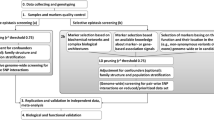Abstract
Any genome-wide analysis is hampered by reduced statistical power due to multiple comparisons. This is particularly true for interaction analyses, which have lower statistical power than analyses of associations. To assess gene–environment interactions in population settings we have recently proposed a statistical method based on a modified two-step approach, where first genetic loci are selected by their associations with disease and environment, respectively, and subsequently tested for interactions. We have simulated various data sets resembling real world scenarios and compared single-step and two-step approaches with respect to true positive rate (TPR) in 486 scenarios and (study-wide) false positive rate (FPR) in 252 scenarios. Our simulations confirmed that in all two-step methods the two steps are not correlated. In terms of TPR, two-step approaches combining information on gene-disease association and gene–environment association in the first step were superior to all other methods, while preserving a low FPR in over 250 million simulations under the null hypothesis. Our weighted modification yielded the highest power across various degrees of gene–environment association in the controls. An optimal threshold for step 1 depended on the interacting allele frequency and the disease prevalence. In all scenarios, the least powerful method was to proceed directly to an unbiased full interaction model, applying conventional genome-wide significance thresholds. This simulation study confirms the practical advantage of two-step approaches to interaction testing over more conventional one-step designs, at least in the context of dichotomous disease outcomes and other parameters that might apply in real-world settings.







Similar content being viewed by others
References
Thomas D. Gene–environment-wide association studies: emerging approaches. Nat Rev Genet. 2010;11(4):259–72.
Piegorsch WW, Weinberg CR, Taylor JA. Non-hierarchical logistic models and case-only designs for assessing susceptibility in population-based case-control studies. Stat Med. 1994;13(2):153–62.
Mukherjee B, Ahn J, Gruber SB, Rennert G, Moreno V, Chatterjee N. Tests for gene–environment interaction from case–control data: a novel study of type I error, power and designs. Genet Epidemiol. 2008;32(7):615–26.
Mukherjee B, Chatterjee N. Exploiting gene–environment independence for analysis of case-control studies: an empirical Bayes-type shrinkage estimator to trade-off between bias and efficiency. Biometrics. 2008;64(3):685–94.
Kraft P, Yen YC, Stram DO, Morrison J, Gauderman WJ. Exploiting gene–environment interaction to detect genetic associations. Hum Hered. 2007;63(2):111–9.
Murcray CE, Lewinger JP, Gauderman WJ. Gene–environment interaction in genome-wide association studies. Am J Epidemiol. 2009;169(2):219–26.
Ege MJ, Strachan DP, Cookson WO, Moffatt MF, Gut I, Lathrop M, et al. Gene–environment interaction for childhood asthma and exposure to farming in Central Europe. J Allergy Clin Immunol. 2011;127(1):138–44.
Murcray CE, Lewinger JP, Conti DV, Thomas DC, Gauderman WJ. Sample size requirements to detect gene–environment interactions in genome-wide association studies. Genet Epidemiol. 2011;35(3):201–10.
Mukherjee B, Ahn J, Gruber SB, Chatterjee N. Testing gene–environment interaction in large-scale case-control association studies: possible choices and comparisons. Am J Epidemiol. 2012;175(3):177–90.
Dudbridge F, Gusnanto A. Estimation of significance thresholds for genomewide association scans. Genet Epidemiol. 2008;32(3):227–34.
Chatterjee N, Wacholder S. Invited commentary: efficient testing of gene–environment interaction. Am J Epidemiol. 2009;169(2):231–3. doi:10.1093/aje/kwn352.
Thomas DC, Lewinger JP, Murcray CE, Gauderman WJ. Invited commentary: GE-Whiz! ratcheting gene–environment studies up to the whole genome and the whole exposome. Am J Epidemiol. 2012;175(3):203–7.
Wason JM, Dudbridge F. A general framework for two-stage analysis of genome-wide association studies and its application to case-control studies. Am J Hum Genet. 2012;90(5):760–73.
Kooperberg C, Leblanc M. Increasing the power of identifying gene × gene interactions in genome-wide association studies. Genet Epidemiol. 2008;32(3):255–63.
Acknowledgments
This work was supported by the European Commission as part of GABRIEL (A multidisciplinary study to identify the genetic and environmental causes of asthma in the European Community) Contract Number 018996 under the Integrated Program LSH-2004-1.2.5-1. M.J.E received the Stephan-Weiland Fellowship of the GABRIEL consortium.
Author information
Authors and Affiliations
Corresponding author
Electronic supplementary material
Below is the link to the electronic supplementary material.
Rights and permissions
About this article
Cite this article
Ege, M.J., Strachan, D.P. Comparisons of power of statistical methods for gene–environment interaction analyses. Eur J Epidemiol 28, 785–797 (2013). https://doi.org/10.1007/s10654-013-9837-4
Received:
Accepted:
Published:
Issue Date:
DOI: https://doi.org/10.1007/s10654-013-9837-4




